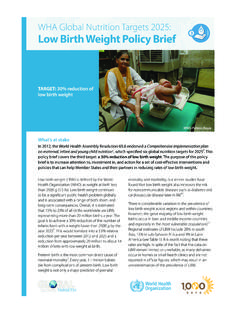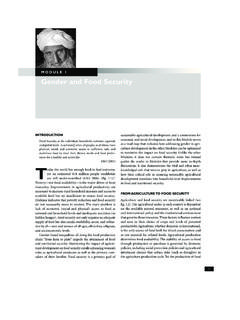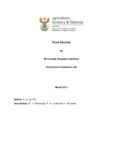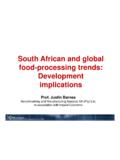Transcription of Nutrition Basics and Applications - Jones & Bartlett …
1 1 PARTIN utrition Basicsand ApplicationsChapter 1 Introduction to NutritionChapter 2 food HabitsChapter 3 Proteins and HealthChapter 4 Carbohydrates and Fats: Implications for HealthChapter 5 Vitamins and HealthChapter 6 Minerals, Water, and Body ProcessesChapter 7 Meeting Energy Needs Jones and Bartlett Publishers, LLC. NOT FOR SALE OR DISTRIBUTION Jones and Bartlett Publishers, LLC. NOT FOR SALE OR DISTRIBUTION3 CHAPTER1 Introduction to NutritionTime for completionActivities: 11 2hoursOptional examination: 1 2hourOUTLINEO bjectivesGlossaryBackground informationACTIVITY 1: DietaryAllowances, Eating Guides,and food Guidance SystemDietary StandardsDietary GuidelinesFood Guidance SystemFood Exchange ListsResponsibilities of HealthPersonnelProgress Check on Activity 1 ACTIVITY 2: Legislation andHealth PromotionFood LabelingDietary Supplement LawNational Cholesterol EducationProgram (NCEP)Functional Foods andNutraceuticalsResponsibilities of HealthPersonnelProgress Check on Activity 2 ReferencesOBJECTIVESUpon completion of this chapter, the student should be able to do thefollowing:1.
2 Define major concepts and terms used in nutritional Identify guidelines and rationale used for planning and evaluating Describe some major concerns about the American Use appropriate sources and services to obtain reliable diet:one that provides all the essential nutrients and calories neededto maintain good health and acceptable body Intake (AI):an estimate of average requirements when evidence isnot available to establish an (Cal):unit of energy, often used for the term kilocalorie (see alsokilo-calorie). Common usage indicating the release of energy from : the beliefs, arts, and customs that make up a way of life for a groupof people. Jones and Bartlett Publishers, LLC. NOT FOR SALE OR DISTRIBUTION4 PART 1 Nutrition Basics AND APPLICATIONSD aily Reference Values (DRVs): a set of values that cov-ers nutrients, such as fat and fiber, that do not appearin the RDA tables. Expressed as % Daily Value (%DV).Diet:(a) the foods that a person eats most frequently; (b) food considered in terms of its qualities and effectson health; (c) a particular selection of food , usuallyprescribed to cure a disease or to gain or lose Guidelines for Americans:dietary recommenda-tions to promote health and to prevent or delay theonset of chronic Reference Intakes (DRIs): a set of dietary refer-ence values including but not limited Adequate Intake(AI), Estimated Average Requirement (EAR), Rec-ommended Dietary Allowance (RDA), and TolerableUpper Intake Level (UL) used for planning and assess-ing diets of individuals and :capacity to do work; also refers to calories, thatis, the fuel provided by certain nutrients (carbohy-drates, fats, proteins).
3 Estimated Average Requirement (EAR):intake thatmeets the estimated nutrient needs of one half of theindividuals in a specific group. Used as a basis for de-veloping the :any substance taken into the body that will help tomeet the body s needs for energy, maintenance, nutritional status: the intake of a balanced diet con-taining all the essential nutrients to meet the body s re-quirements for energy, maintenance, and (g): a unit of weight in the metric system. 1 g =.036 oz. There are grams to an ounce. Thisconversion is usually rounded to 30 g for ease in cal-culation, or rounded down to 28 :the state of complete physical, mental, and socialwell-being; not merely the absence of disease (kcalorie, kcal):technically correct term forunit of energy in Nutrition , equal to the amount of heatrequired to raise the temperature of 1 kg of water 1 :state of impaired health due to undernutri-tion, overnutrition, an imbalance of nutrients, or thebody s inability to utilize the nutrients :a unit of weight in the metric system equalto 1/1,000,000 of a :a unit of weight in the metric system equal to1/1,000 of a :to watch over or observe something for a periodof Cholesterol Education Program (NCEP):pro-gram designed to educate the public and healthcareproviders about the risks of an elevated cholesterollevel and methods to lower :a chemical substance obtained from food andneeded by the body for growth, maintenance, or repairof tissues.
4 Many nutrients are considered body cannot make them; they must be obtainedfrom :the sum of the processes by which food is se-lected and becomes part of the status:state of the body resulting from the in-take and use of Nutrition : the state of receiving and utilizingessential nutrients to maintain health and well-beingat the highest possible level. It provides a reserve forthe :an excessive intake of one or more nutri-ents, frequently referring to nutrients providing en-ergy (kcalories).Poor nutritional status: an inadequate intake (or utiliza-tion) of nutrients to meet the body s requirements forenergy, maintenance, and Dietary Allowances (RDAs):levels of nu-trients recommended by the food and NutritionBoard of the National Academy of Sciences for dailyconsumption by healthy individuals, scaled accordingto sex and Upper Intake Level (UL):maximum intake byan individual that is unlikely to pose risks of adversehealth effects in a healthy individual in a specifiedgroup.
5 There is no established standard for individu-als to consume nutrients at levels above the RDA or :a deficiency of one or more nutrients, in-cluding nutrients providing energy (calories).BACKGROUNDINFORMATIONThe subject of Nutrition is both exciting and confusing tothe beginning student. Nutrition has become a majortopic of conversation at places of work, at social gather-ings, and in the media. We are living at a time when thefocus is on prevention of disease and responsibility forone s own health. The newest trends in health care em-phasize the importance of Nutrition history, food and its effects on the bodyhave been studied and written about, but most of the in-formation gathered was based on trial and error. Many su-perstitions regarding the magical powers and healingcapabilities of food also study of Nutrition as a science is relatively new,developing only after chemistry and physiology becameestablished disciplines. Its growth begins with the endof World War II. Nutrition science is now a highly re-garded discipline.
6 The progressive advances in the sci-ence and technology of this discipline offer us hope incontrolling our destiny by preventing or delaying theonset of a number of chronic diseases related to nutri-tion, food , and specialized field has its own language. A begin-ning student in Nutrition needs to comprehend the lan-guage used in this discipline and to understand somebasic concepts upon which the science is based. The ac-tivities in this chapter should assist you in gaining theknowledge and vocabulary necessary to understand thescience of Nutrition . Jones and Bartlett Publishers, LLC. NOT FOR SALE OR DISTRIBUTIONACTIVITY 1:Dietary Allowances, Eating Guides, andFood Guidance SystemThe appropriate diet at any stage of life is one that sup-plies sufficient energy and all the essential nutrients inadequate amounts for health. For more than 50 years,professionals from the government and academics havemade recommendations on such basic more than two decades there has been increasingconcern about the eating patterns of American health policy makers have linked several spe-cific dietary factors to chronic diseases among the pop-ulation.
7 This connection between diet and disease has, inturn, led to publication of guidelines to promote health-ier eating habits. Most of these publications have been is-sued by relevant units within the following nationalagencies:1. National Academy of Sciences (NAS)2. Department of Agriculture3. Department of Health and Human Services4. National Institute of Health5. Surgeon GeneralAccording to these agencies, the major chronic dis-eases in the United States are coronary heart disease,strokes, hypertension, atherosclerosis, some cancers,obesity, and diabetes. Several high-risk factors for thesediseases are linked to the American diet. A discussion ofthese health factors and a proper diet presented in suchnational publications as Healthy People 2000, AmericanDietary Guidelines, and MyPyramidwill be presented inthis chapter. We will first look into the concept of dietarystandards in the United STANDARDST here are two basic questions regarding dietary standards:What are the nutrients in food ?
8 How much of each nutri-ent do we need everyday to be healthy? Collectively, this in-formation is the core of the Dietary Standards. Eachcountry has its own dietary standard, and no two countrieshave the same standards, for a variety of more than half a century the NationalAcademy of Sciences (NAS) has been the major scientificarm of the federal government to provide answers tothese questions. The NAS in turn depends on one of itsinstitutes, the Institute of Medicine (IOM), to review sci-entific literature to arrive at the appropriate has developed many boards of experts to performsuch scientific investigations. One such board is the Foodand Nutrition Board (FNB) which is the actual scientificbody that develops most of the dietary present the FNB is using the concept of dietary ref-erence standards to define the terms describing theamount of nutrients we consume, such as recommen-dation, requirement, dietary allowances, adequate in-take, upper limits, tolerance, estimation, average re-quirements,and so on.
9 In general, there are four sets ofreference data, collectively called Dietary ReferenceIntakes or DRIs: Estimated Average Requirement (EAR),Recommended Dietary Allowance (RDA), Adequate Intake(AI), and Tolerable Upper Intake Level (UL). They are de-fined as follows: Estimated Average Requirement (EAR): The intakethat meets the estimated nutrient needs of half of theindividuals in a specific group. This figure is to beused as the basis for developing the RDA and is to be used by Nutrition policy makers in evaluating theadequacy of nutrient intakes of the group and for plan-ning how much the group should consume. Recommended Dietary Allowance (RDA): The intakethat meets the nutrient needs of almost all of thehealthy individuals in a specific age and gender RDA should be used in guiding individuals toachieve adequate nutrient intake aimed at decreasingthe risk of chronic disease. It is based on estimatingan average requirement plus an increase to accountfor the variation within a particular group.
10 Adequate Intake (AI): When sufficient scientific evi-dence is not available to estimate an average require-ment, Adequate Intakes (AIs) have been should use the AI as a goal for intakewhere no RDAs exist. The AI is derived through ex-perimental or observational data that show a meanintake that appears to sustain a desired indicator ofhealth, such as calcium retention in bone for mostmembers of a population group. For example, AIs havebeen set for infants through 1 year of age using the av-erage observed nutrient intake of populations ofbreastfed infants as the standard. The committee setAIs for calcium, vitamin D, and fluoride. Tolerable Upper Intake Level (UL): The maximum in-take by an individual that is unlikely to pose risks ofadverse health effects in almost all healthy individu-als in a specified group. This figure is not intended tobe a recommended level of intake, and there is no es-tablished benefit for individuals to consume nutrientsat levels above the RDA or AI.

















